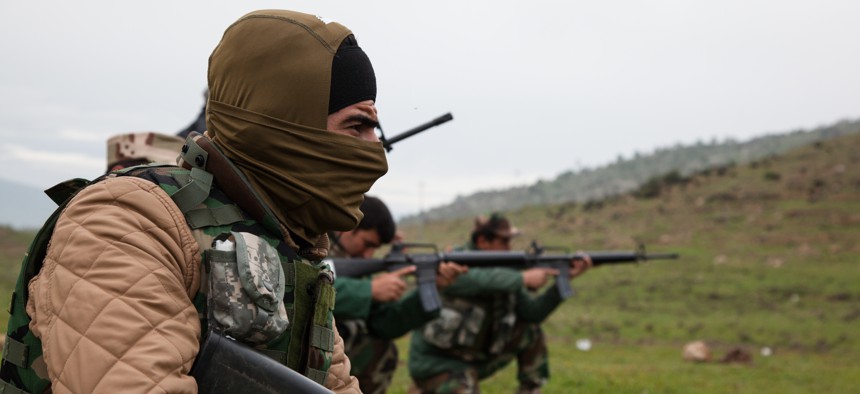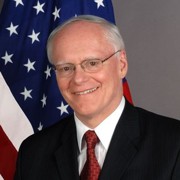
A Peshmerga soldier participates in a live-fire exercise under the supervision and instruction of soldiers from the Netherlands near Erbil, Iraq, March 27, 2016. U.S. Army photo by Spc. Jessica Hurst
Leave Root Causes Aside—Destroy the ISIS ‘State’
Of course it would be daunting to solve the conflicts the Islamic State feeds on. But that isn’t, or shouldn’t be, the mission.
Stephen Biddle and Jacob Shapiro’s recent Atlantic article, “America Can’t Do Much About ISIS,” advocated containing the Islamic State and questioned America’s ability to destroy the group. The first problem with this analysis is how the authors define “destroy ISIS.” They compare the amorphous fight against al-Qaeda with the one against ISIS, discussing how to get at the roots of its terrorist ideology and fix the ungoverned space that provides its sanctuary. This leads them repeatedly to conflate destroying ISIS in its current form as a quasi-state with the monumental task of resolving the Syrian Civil War and the Sunni-Shia split in Iraq. To the contrary, if the mission is properly defined, America can destroy ISIS, and must.
Defeating ISIS-as-state is not dependent upon solving Syria as a social, historical, cultural, religious, and governance project, let alone doing the same with Iraq. ISIS feeds on the conflicts in both countries and makes the situation in both worse. But it is possible to defeat ISIS as a “state” and as a military-economic “power”—that is, deal with the truly threatening part— without having to solve the Syrian and Iraqi crises or eliminate ISIS as a set of terrorist cells or source of ideological inspiration. Of course, even if ISIS is destroyed as a state, we would still have the Syrian Civil War and Iraqi disunity, but we have all that now, along with ISIS, which presents its own challenges to the region and the West.
Normally, if one opts not to ignore a foreign-policy problem, the two choices are: Fix it (which in ISIS’s case would mean defeat and destroy it, per America’s official policy), or contain it. The choice is made based on an analysis of the likely costs and risks of eliminating the problem versus those of living with it, as well as the impact of one’s decision on broader concerns. From both points of view, Biddle and Shapiro’s arguments are flawed.
Admittedly the costs of destroying ISIS as a jihadist ideological movement, and its remnants as an insurgency (i.e., what it was in Iraq before 2014), not to speak of “fixing” Syria and Iraq, are just as daunting as Biddle and Shapiro repeatedly argue. But that isn’t, or shouldn’t be, the mission. The mission should be crushing ISIS as a state and as a military and economic power. That is a different challenge, and one far more responsive to conventional military power. Local forces with minimal U.S. indirect support have already made progress in some areas, including recently in Shadadi, Syria, and Ramadi, Iraq. ISIS has fewer foot soldiers than at any time since 2014, and has problems, as the authors note, paying its bills.
A much more robust indirect support package of advisers, artillery, and attack helicopters, more special-operations raids, and even more liberal rules of engagement for air strikes than those just adopted (decentralizing strike decisions, accepting slightly higher risk of civilian casualties, and using more airpower and more powerful bombs) could generate more rapid victories. A limited commitment of U.S. ground troops—two brigades of 5,000 troops each, reinforced by other NATO forces, along with local allies—could make even more rapid progress. These would supplement the 5,000 or so American troops now in Iraq training local forces and the 250 special-operations forces just deployed to Syria. Thus even a tweaking of current U.S. indirect support (now in the works), and certainly limited direct American combat, could destroy ISIS relatively rapidly as a “state” and “army.” That would leave a “day after” problem, but would solve ISIS-as-a-state.
See also: The Future of Intelligence Sharing Is Coming Together in the Syrian War
Read more: ISIS and the ‘Loser Effect’
Related: Obama Drops Rhetoric as Assad Drops Barrel Bombs
And the U.S., at least sometimes, has effectively dealt with such “days after” without massive American troop presence, from northern Iraq after the Gulf War in 1991, to Kosovo, El Salvador, and Colombia. But even a messy post-ISIS situation is better than containment, given that course’s dangers and costs. It’s those, which the authors largely ignore, that have to be weighed against the costs of destroying the ISIS state.
The costs of containment begin with a huge military campaign, in terms of time (almost two years so far, with no end in sight), forces (thousands of American ground troops, large coalition contributions, hundreds of aircraft, hundreds of thousands of Iraqi regular and Iraqi and Syrian irregular forces), and money ($7 billion so far, with billions more spent by the Iraqis), just to “contain” and slowly degrade ISIS.
Right now, maintaining troops and dealing with millions of internally displaced persons is bankrupting the Iraqi state (and the Kurdistan government) and generating much political turbulence. If those governments start collapsing, any “containment” strategy would as well.
Finally, if you don't deal with a problem, particularly in the Middle East, it usually gets worse. The Syrian Civil War, unchecked, eventually spawned ISIS, a migration crisis straining Europe, and a worrisome Russian intervention.
Until ISIS is destroyed as a state, it can still launch horrific terrorist attacks, provoke political collapse in Baghdad or among the Iraqi Kurds, and even trigger a descent into a Sunni-Shia regional conflict, if Shia Iran targets ISIS and thereby threatens the Sunni Arab territory in which ISIS is nested. (ISIS remnants could still threaten terrorist attacks, but not of the same magnitude or with the same geostrategic consequences.)
The second consideration in any decision about how to handle a foreign-policy problem is its impact on broader foreign relations. For example, in 2007, the U.S. opted not to act itself against Syria’s secret al-Kibar nuclear reactor, which Israel destroyed in an airstrike that year. This was not because U.S. action was less risky than an Israeli attack, but largely because America’s “plate” in the Middle East was full with two wars, along with negotiations over Iran’s nuclear program and the Israeli-Palestinian conflict. But today, after Obama’s 2013 failure to enforce his self-declared “red line” against the use of chemical weapons in Syria by the forces of Syrian president Bashar al-Assad, the U.S. needs to build credibility that it will follow up threats of force with action to counter states like Iran, Russia, China, and North Korea that threaten the existing global order. The best place to build such credibility, with maximum chance of success and least escalation risk, is the fight against ISIS.
Finally, Biddle and Shapiro’s arguments all would have sounded equally reasonable if made against Russian President Vladimir Putin’s Syrian intervention. But he went ahead, and with a fraction of America’s diplomatic and military capabilities achieved a limited but important victory, avoiding the “quagmire” President Obama predicted. And America can’t?
NEXT STORY: ISIS and the 'Loser Effect'




